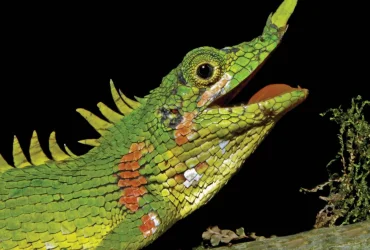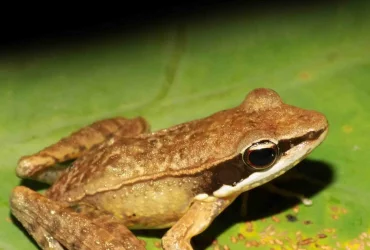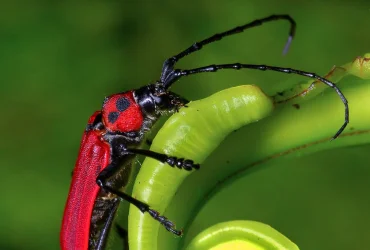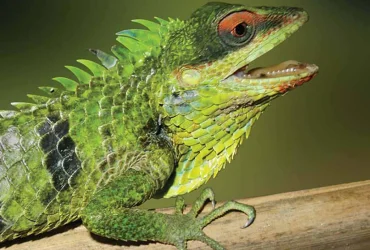Archives
 v9i1.215
v9i1.215ISSN: 1800-427X (printed)
eISSN: 1800-427X (online)
DOI:10.47605/tapro.v9i1.215
Published date: 21 May 2020
Pp. 1–2
EDITORIAL : The IUCN Red List and its role in data-driven conservation
Philip Bowles
Deputy Editor: Taprobanica, the journal of Asian Biodiversity
“When in America hundreds of thousands of acres of primeval forest are annually destroyed the conditions of life of a numerous fauna and flora must be thereby suddenly changed, leaving no choice but extermination” – Weissmann 1882
eISSN: 1800-427X (online)
DOI:10.47605/tapro.v9i1.215
Published date: 21 May 2020
Pp. 1–2
EDITORIAL : The IUCN Red List and its role in data-driven conservation
Philip Bowles
Deputy Editor: Taprobanica, the journal of Asian Biodiversity
“When in America hundreds of thousands of acres of primeval forest are annually destroyed the conditions of life of a numerous fauna and flora must be thereby suddenly changed, leaving no choice but extermination” – Weissmann 1882
 v9i1.226
v9i1.226ISSN: 1800-427X (printed)
eISSN: 1800-427X (online)
DOI:10.47605/tapro.v9i1.226
Submitted date: 29 July 2020
Accepted date: 30 August 2020
Published date: 03 September 2020
Pp. 121–132, pls. 43–45.
A REASSESSMENT OF THE SYSTEMATIC POSITION OF THE ASIAN RANID FROG Hylorana nicobariensis STOLICZKA, 1870 (AMPHIBIA : ANURA) WITH THE DESCRIPTION OF A NEW GENUS
S.R. Chandramouli*, Amir Hamidy & A.A. Thasun Amarasinghe
*Corresponding author. E-mail: findthesnakeman@gmail.com
Abstract
We reassessed the systematic position of the ranid frog Hylorana (=Hylarana) nicobariensis that, owing to its uncertain phylogenetic position and lack of clear morphological characterisation, has lately been allocated to various Asian and African frog genera such as Rana, Sylvirana, Hylarana, Amnirana, and most recently to Indosylvirana. Based on an integrative approach of both phylogenetic and morphological affinities, we describe a new genus to accommodate Hylorana (=Hylarana) nicobariensis and redescribe the species based on new topotypic material from the Nicobar Islands.
Key words : Amnirana, Indosylvirana, phylogeny, Southeast Asia, Sundaland, taxonomy
Section Editor: Enrique La Marca
LSID:urn:lsid:zoobank.org
eISSN: 1800-427X (online)
DOI:10.47605/tapro.v9i1.226
Submitted date: 29 July 2020
Accepted date: 30 August 2020
Published date: 03 September 2020
Pp. 121–132, pls. 43–45.
A REASSESSMENT OF THE SYSTEMATIC POSITION OF THE ASIAN RANID FROG Hylorana nicobariensis STOLICZKA, 1870 (AMPHIBIA : ANURA) WITH THE DESCRIPTION OF A NEW GENUS
S.R. Chandramouli*, Amir Hamidy & A.A. Thasun Amarasinghe
*Corresponding author. E-mail: findthesnakeman@gmail.com
Abstract
We reassessed the systematic position of the ranid frog Hylorana (=Hylarana) nicobariensis that, owing to its uncertain phylogenetic position and lack of clear morphological characterisation, has lately been allocated to various Asian and African frog genera such as Rana, Sylvirana, Hylarana, Amnirana, and most recently to Indosylvirana. Based on an integrative approach of both phylogenetic and morphological affinities, we describe a new genus to accommodate Hylorana (=Hylarana) nicobariensis and redescribe the species based on new topotypic material from the Nicobar Islands.
Key words : Amnirana, Indosylvirana, phylogeny, Southeast Asia, Sundaland, taxonomy
Section Editor: Enrique La Marca
LSID:urn:lsid:zoobank.org
 Latest Articles
Latest Articles361_An overview of human-snake conflict from 2015 to 2023 in Indonesia
Zakky et al. | 88-98pp
362_A new species of amphidromous goby (Teleostei: Oxudercidae: Stiphodon) from Enggano Island, Indonesia
Nurjirana et al. | 99-106pp
363_A new day gecko of the Cnemaspis podihuna (Reptilia: Gekkonidae) clade from Northeast India
Sayyed et al. | 107-120pp
364_Impacts of bimaturism and fruit availability on the behaviour of male Sumatran orangutans, Pongo abelii Lesson, 1827 (Primates: Hominidae)
Rahmaeti et al. | 121-131pp
365_Influence of land surface temperature and vegetation cover on bird communities in the urban landscape of Yogyakarta
Naufalianto et al. | 132-149pp
366_Macroalgae as blue carbon vegetation: Seasonal trends in biomass and carbon storage on Java's south coast
Agustiana et al. | 150-157pp
367_A new species of the genus Smithophis Giri, Gower, Das et al., 2019 (Reptilia: Serpentes: Natricidae) from Mizoram, northeast India
Muansanga et al. | 158-165pp
368_Ecological risk analysis of harmful algal blooms (HABs) in Bima Bay, West Nusa Tenggara, Indonesia
Jalaludin et al. | 166-173pp
369_A geospatial approach to the distribution, density, and hotspots of freshwater crabs (Decapoda: Gecarcinucidae) in Sri Lanka
Gabadage et al. | 174-179pp
370_Species richness, endemism and biogeography of freshwater diatoms (Ochrophyta: bacillariophyceae) from Indonesia: a review
Swastiki et al. | 180-187pp
371_Comparative morphology and advertisement call of Microhyla fissipes Boulenger, 1884 and M. heymonsi Vogt, 1911 (Amphibia: Microhylidae) from Taiwan
Hasan et al. | 188-194pp
372_First descriptions of the adult male and tadpoles of Leptobrachella korifi Matsui, Panha & Eto, 2023 (Amphibia: Megophryidae)
Rongchapho et al. | 195-205pp
373_Diversity, seasonality, and herbivore palatability of the grasses of Kavaledurga Fort, Western Ghats, India
Abhijit et al. | 206-213pp
374_Decoding archaeofaunal biodiversity in the karma vibhanga (karmawibhangga) reliefs of Borobudur Temple – Indonesia, and its implicit meanings
Maryanto et al. | 214-229pp
375_Immunogenetic insights and conservation of the endemic lempuk fish (Gobiiformes: Gobiopterus)
Hertika et al. | 230-235pp
376_Butterfly indicators and assemblage patterns in urbanized Greater Jakarta
Winarni et al. | 236-244pp
377_Two new species of the Hylarana signata complex (Anura: Ranidae) from Sumatra and the distribution of H. sundabarat (Chan, Abraham, Grismer & Brown, 2020)
Ribut et al. | 245-259pp
378_The “kalpataru” philosophy as an Indonesian paradigm of biodiversity: insights from the karmawibhaṅga reliefs of Borobudur
Maryanto et al. | 260-274pp
379_Mapping the scientific landscape of environmental pollution research: a bibliometric approach
Mulianda et al. | 275-282pp
380_A comprehensive bibliometric analysis of otolith research on eels
Kusna et al. | 283-292pp
381_Book Review: Spesies Apakah Itu? [What Species Is That?]
Purwanto et al. | 293-295pp
382_Ophiophagy in the saw-scaled viper (Echis carinatus) from the UAE
Madurapperuma | 296-298pp
383_Anatomy of the nuchal glands in red-necked keelback (Rhabdophis subminiatus)
Narindria et al. | 299-302pp
384_Two newly recorded gobiid fishes (Sicyopus spp.) from Sumatra, Indonesia
Harefa et al. | 302-308pp
385_First record of the cobweb spider (Steatoda erigoniformis) from Gujarat
Parmar & Pandya | 309pp
386_Comparative assessment of avian diversity in cemented and non-cemented ponds
Khandelwal et al. | 310-312pp
387_Seahorses and pipefishes of Sri Lanka (Teleostei: Syngnathidae)
Bandara et al. | 313-317pp
388_Interference avoidance by wild ungulates at a mineral lick, Central Kalimantan
Wicaksono et al. | 318-322pp
389_On the partial TLR21 gene from the feathers of birds, a chicken, and a duck
Sumarsono et al. | 323-324pp
390_Allofeeding behavior in wild Pesquet’s parrots (Psittrichas fulgidus)
Pramunandya & Haryoko | 325-326pp
391_On the arrow-tailed flying squirrel (Hylopetes sagitta) from Mt. Ungaran, Java
Rahayuningsih et al. | 327-329pp
392_Leopard cat (Prionailurus bengalensis) uses caves as a refuge in Maharashtra
Patil et al. | 330-331pp
393_New country record of a planthopper (Pyrops viridirostris) from Bangladesh
Barkat et al. | 332-333pp
394_White-haired Trachypithecus cristatus on Gunung Kubing, Belitung
Azyati et al. | 334-336pp
395_Venomous snake distribution in Indonesia from citizen science and museum data
Anita et al. | 337-342pp
Zakky et al. | 88-98pp
362_A new species of amphidromous goby (Teleostei: Oxudercidae: Stiphodon) from Enggano Island, Indonesia
Nurjirana et al. | 99-106pp
363_A new day gecko of the Cnemaspis podihuna (Reptilia: Gekkonidae) clade from Northeast India
Sayyed et al. | 107-120pp
364_Impacts of bimaturism and fruit availability on the behaviour of male Sumatran orangutans, Pongo abelii Lesson, 1827 (Primates: Hominidae)
Rahmaeti et al. | 121-131pp
365_Influence of land surface temperature and vegetation cover on bird communities in the urban landscape of Yogyakarta
Naufalianto et al. | 132-149pp
366_Macroalgae as blue carbon vegetation: Seasonal trends in biomass and carbon storage on Java's south coast
Agustiana et al. | 150-157pp
367_A new species of the genus Smithophis Giri, Gower, Das et al., 2019 (Reptilia: Serpentes: Natricidae) from Mizoram, northeast India
Muansanga et al. | 158-165pp
368_Ecological risk analysis of harmful algal blooms (HABs) in Bima Bay, West Nusa Tenggara, Indonesia
Jalaludin et al. | 166-173pp
369_A geospatial approach to the distribution, density, and hotspots of freshwater crabs (Decapoda: Gecarcinucidae) in Sri Lanka
Gabadage et al. | 174-179pp
370_Species richness, endemism and biogeography of freshwater diatoms (Ochrophyta: bacillariophyceae) from Indonesia: a review
Swastiki et al. | 180-187pp
371_Comparative morphology and advertisement call of Microhyla fissipes Boulenger, 1884 and M. heymonsi Vogt, 1911 (Amphibia: Microhylidae) from Taiwan
Hasan et al. | 188-194pp
372_First descriptions of the adult male and tadpoles of Leptobrachella korifi Matsui, Panha & Eto, 2023 (Amphibia: Megophryidae)
Rongchapho et al. | 195-205pp
373_Diversity, seasonality, and herbivore palatability of the grasses of Kavaledurga Fort, Western Ghats, India
Abhijit et al. | 206-213pp
374_Decoding archaeofaunal biodiversity in the karma vibhanga (karmawibhangga) reliefs of Borobudur Temple – Indonesia, and its implicit meanings
Maryanto et al. | 214-229pp
375_Immunogenetic insights and conservation of the endemic lempuk fish (Gobiiformes: Gobiopterus)
Hertika et al. | 230-235pp
376_Butterfly indicators and assemblage patterns in urbanized Greater Jakarta
Winarni et al. | 236-244pp
377_Two new species of the Hylarana signata complex (Anura: Ranidae) from Sumatra and the distribution of H. sundabarat (Chan, Abraham, Grismer & Brown, 2020)
Ribut et al. | 245-259pp
378_The “kalpataru” philosophy as an Indonesian paradigm of biodiversity: insights from the karmawibhaṅga reliefs of Borobudur
Maryanto et al. | 260-274pp
379_Mapping the scientific landscape of environmental pollution research: a bibliometric approach
Mulianda et al. | 275-282pp
380_A comprehensive bibliometric analysis of otolith research on eels
Kusna et al. | 283-292pp
381_Book Review: Spesies Apakah Itu? [What Species Is That?]
Purwanto et al. | 293-295pp
382_Ophiophagy in the saw-scaled viper (Echis carinatus) from the UAE
Madurapperuma | 296-298pp
383_Anatomy of the nuchal glands in red-necked keelback (Rhabdophis subminiatus)
Narindria et al. | 299-302pp
384_Two newly recorded gobiid fishes (Sicyopus spp.) from Sumatra, Indonesia
Harefa et al. | 302-308pp
385_First record of the cobweb spider (Steatoda erigoniformis) from Gujarat
Parmar & Pandya | 309pp
386_Comparative assessment of avian diversity in cemented and non-cemented ponds
Khandelwal et al. | 310-312pp
387_Seahorses and pipefishes of Sri Lanka (Teleostei: Syngnathidae)
Bandara et al. | 313-317pp
388_Interference avoidance by wild ungulates at a mineral lick, Central Kalimantan
Wicaksono et al. | 318-322pp
389_On the partial TLR21 gene from the feathers of birds, a chicken, and a duck
Sumarsono et al. | 323-324pp
390_Allofeeding behavior in wild Pesquet’s parrots (Psittrichas fulgidus)
Pramunandya & Haryoko | 325-326pp
391_On the arrow-tailed flying squirrel (Hylopetes sagitta) from Mt. Ungaran, Java
Rahayuningsih et al. | 327-329pp
392_Leopard cat (Prionailurus bengalensis) uses caves as a refuge in Maharashtra
Patil et al. | 330-331pp
393_New country record of a planthopper (Pyrops viridirostris) from Bangladesh
Barkat et al. | 332-333pp
394_White-haired Trachypithecus cristatus on Gunung Kubing, Belitung
Azyati et al. | 334-336pp
395_Venomous snake distribution in Indonesia from citizen science and museum data
Anita et al. | 337-342pp
 v5i1.83
v5i1.83ISSN: 1800-427X (print)
eISSN: 1800-427X (online)
DOI:10.47605/tapro.v5i1.83
Published date: 15 June 2013
Pp. 1–5
EDITORIAL : Wildlife Poaching Increasing
Lee E. Harding*
*Section Editor: Taprobanica, the journal of Asian Biodiversity
After decades of endangered species protection and conservation success, poachers are staging a come–back. Most people in Europe and North America just don’t believe that rhinoceros horn, monkey meat, tiger penis or bear bile have any curative or health properties, but millions of people in East Asia and Southeast Asia believe otherwise. This cultural predilection is driving extinction. As repugnant as it is to those living outside the range of non–human primates, monkey meat provides a much–needed source of protein in some circumstances—but not enough to justify their extinction. There is no such nutritional excuse for poaching tigers, bears or rhinoceros. Since the start of 2008, at least 1800 white rhinoceroses and a few of the rarer black rhinoceroses have been killed in South Africa for their horns, most smuggled into Vietnam and China.
eISSN: 1800-427X (online)
DOI:10.47605/tapro.v5i1.83
Published date: 15 June 2013
Pp. 1–5
EDITORIAL : Wildlife Poaching Increasing
Lee E. Harding*
*Section Editor: Taprobanica, the journal of Asian Biodiversity
After decades of endangered species protection and conservation success, poachers are staging a come–back. Most people in Europe and North America just don’t believe that rhinoceros horn, monkey meat, tiger penis or bear bile have any curative or health properties, but millions of people in East Asia and Southeast Asia believe otherwise. This cultural predilection is driving extinction. As repugnant as it is to those living outside the range of non–human primates, monkey meat provides a much–needed source of protein in some circumstances—but not enough to justify their extinction. There is no such nutritional excuse for poaching tigers, bears or rhinoceros. Since the start of 2008, at least 1800 white rhinoceroses and a few of the rarer black rhinoceroses have been killed in South Africa for their horns, most smuggled into Vietnam and China.
 v1i2.15
v1i2.15ISSN: 1800-427X (print)
eISSN: 1800-427X (online)
DOI:10.47605/tapro.v1i2.15
Submitted date: 30 October 2009
Accepted date: 22 November 2009
Published date: 22 November 2009
Pp. 83–106, pls. 1–4.
THE ORIGINAL DESCRIPTIONS AND FIGURES OF SRI LANKAN GEKKONID LIZARDS (SQUAMATA : GEKKONIDAE OF THE 18TH AND 19TH CENTURIES
A.A. Thasun Amarasinghe*, Aaron M. Bauer, Ivan Ineich, John Rudge, Mohomed M. Bahir & Dinesh E. Gabadage
*Corresponding author. E-mail: thasun.taprobanica@gmail.com
Abstract
Forty-two species/subspecies belonging to eight genera of geckos, family geckonidae, are recognized from Sri Lanka. Twenty of these were described in the period from Linnaeu’s 10th edition of Systema Nature 1758 to 1953. We provide the original text of the descriptions, images of the type specimens, and translations to English of eight descriptions that were written in Dutch, French, German, and Latin.
Key words : English translation, taxonomy, type specimen, Sri Lanka
Section Editor: Richard Wahlgren
eISSN: 1800-427X (online)
DOI:10.47605/tapro.v1i2.15
Submitted date: 30 October 2009
Accepted date: 22 November 2009
Published date: 22 November 2009
Pp. 83–106, pls. 1–4.
THE ORIGINAL DESCRIPTIONS AND FIGURES OF SRI LANKAN GEKKONID LIZARDS (SQUAMATA : GEKKONIDAE OF THE 18TH AND 19TH CENTURIES
A.A. Thasun Amarasinghe*, Aaron M. Bauer, Ivan Ineich, John Rudge, Mohomed M. Bahir & Dinesh E. Gabadage
*Corresponding author. E-mail: thasun.taprobanica@gmail.com
Abstract
Forty-two species/subspecies belonging to eight genera of geckos, family geckonidae, are recognized from Sri Lanka. Twenty of these were described in the period from Linnaeu’s 10th edition of Systema Nature 1758 to 1953. We provide the original text of the descriptions, images of the type specimens, and translations to English of eight descriptions that were written in Dutch, French, German, and Latin.
Key words : English translation, taxonomy, type specimen, Sri Lanka
Section Editor: Richard Wahlgren
Hubungi Kami
The ultimate aim of the journal is to provide an effective medium for communication of the latest and best scientific information.
Copyright © 2020 Taprobanica. All Rights Reserved
Jasa Pembuatan Website by IKT




